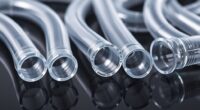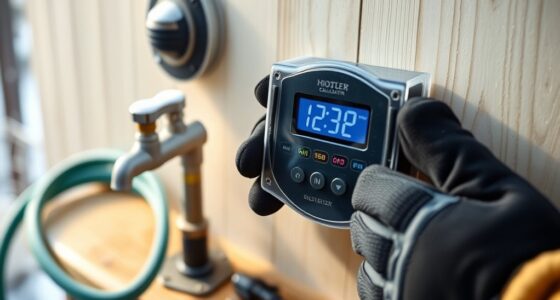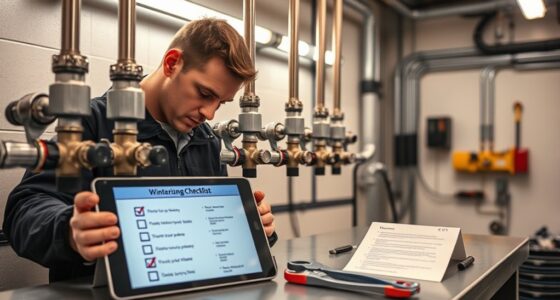Drain and discharge options help you manage excess water around your property to prevent flooding, protect your foundation, and stay environmentally compliant. You can use surface or subsurface drains, rain gardens, soakaways, or stormwater harvesters to handle runoff and rainwater. Wastewater from your home typically flows into sewer systems or septic tanks. Properly choosing, installing, and maintaining these systems is key—stay with us, and you’ll learn how to keep your drainage efficient and trouble-free.
Key Takeaways
- Drainage systems remove excess water from properties to prevent flooding and protect foundations.
- Types include surface drains, underground pipes, and eco-friendly options like rain gardens.
- Discharge methods include gravity flow, pumps, septic tanks, and stormwater harvesting.
- Regular maintenance like cleaning and inspecting pipes prevents clogs and damage.
- Proper planning and compliance with local regulations ensure effective, legal, and environmentally friendly drainage solutions.
What Are Drainage Systems and Why Are They Important?
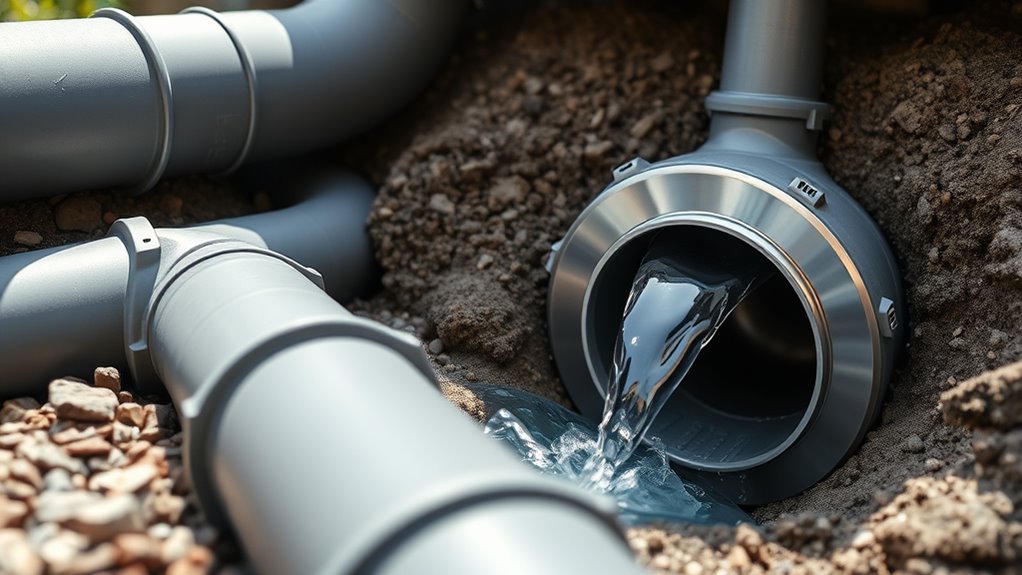
Drainage systems are essential for managing excess water around your property, preventing flooding, and protecting your foundation. They direct rainwater away from your home, reducing water damage and soil erosion. Rainwater harvesting is a key component, allowing you to collect and store rainwater for later use, which eases demand on municipal supplies and reduces runoff. Greywater recycling further enhances water efficiency by reusing water from sinks, showers, and laundry for landscaping or toilet flushing. Proper drainage not only safeguards your property but also promotes sustainable water practices. Installing effective drainage systems ensures that excess water is safely channeled away, preventing pooling and structural issues. Combining these methods helps you manage water responsibly, saving money while contributing to environmental conservation.
Different Types of Drains and How They Work

There are two main types of drains you should know about: surface and subsurface. Surface drains handle water on the ground, while subsurface ones manage water below the surface. You’ll also find systems that rely on gravity or pumps to move water away effectively. The choice between these options depends on the specific drainage needs of the area and the type of water flow involved.
Surface and Subsurface Drains
Have you ever wondered how surface and subsurface drains prevent water from pooling in unwanted areas? These drains work by directing excess water away from permeable surfaces like lawns, driveways, or fields. Surface drains, such as drainage trenches, catch runoff before it infiltrates the soil, reducing erosion and flooding. Subsurface drains, often installed underground, use perforated pipes to channel water beneath the surface. They help lower the water table and keep foundations dry. Both types of drains are essential for managing water flow efficiently and preventing damage to structures or landscapes. Properly installed surface and subsurface drains are crucial tools in controlling excess water and protecting your property. Additionally, understanding drainage technology can help you select the most effective solution for your specific needs.
Gravity vs. Pump Systems
When choosing how to remove excess water from your property, understanding the differences between gravity and pump systems can make a significant impact. Gravity drainage relies on slope and natural force to carry water away, avoiding many drainage pitfalls. It’s simple, cost-effective, and doesn’t have pump limitations, making it ideal for areas with proper terrain. However, if your land isn’t adequately graded, gravity alone might not suffice, leading to standing water or flooding. Pump systems can overcome these issues by actively lifting water to higher elevations, but they come with maintenance needs and potential power failures. Pumps can also be costly and have limits on flow capacity. Carefully evaluate your site’s terrain and water volume to choose the best system, minimizing drainage pitfalls. Proper planning and understanding of drainage systems can greatly improve water management on your property.
How Wastewater Is Typically Discharged From Homes and Businesses
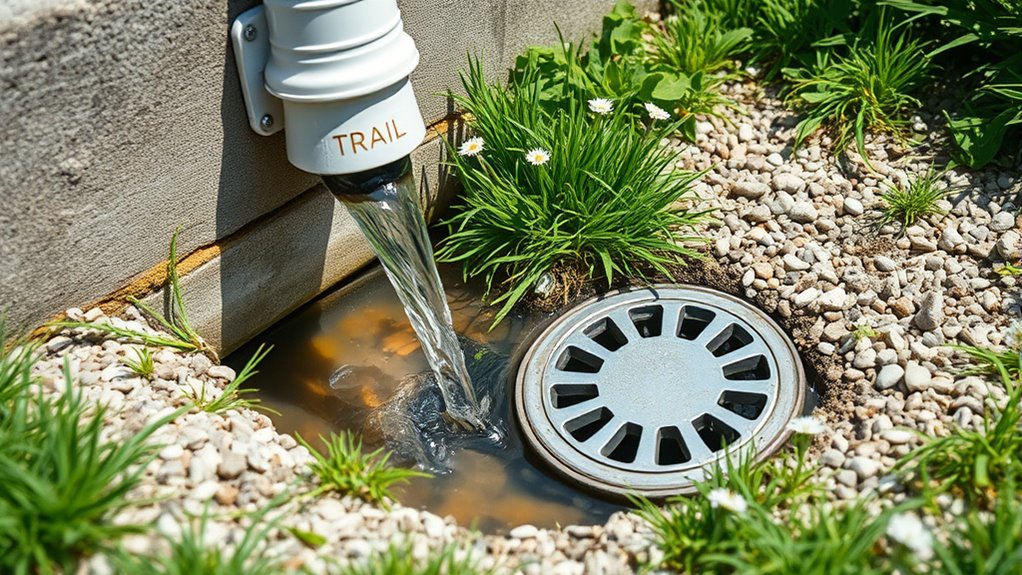
Most homes and businesses discharge wastewater through a network of pipes that connect to sewage systems or treatment facilities. These systems include components like septic tanks, pump stations, and main sewer lines that manage flow and prevent backups. Environmental considerations, such as protecting water quality and preventing pollution, are essential when designing and maintaining these discharge methods. Incorporating wall organization systems can also optimize space and improve the overall functionality of wastewater management areas.
Common Discharge Methods
Typically, wastewater from homes and businesses is discharged through a network of pipes that direct it away from the property and into larger municipal systems or treatment facilities. Common discharge methods include gravity-fed systems, pump stations, and septic tanks. Septic tanks are designed to safely hold and treat wastewater on-site, often using specific irrigation methods to disperse effluent. The choice of method depends on factors like property size and local regulations. Here’s a quick overview:
| Method | Description | Suitable For |
|---|---|---|
| Gravity Drainage | Uses gravity to move wastewater | Small to medium properties |
| Pump Systems | Pumps wastewater to treatment sites | Sloped terrain or large properties |
| Septic Tanks | On-site wastewater treatment | Rural or off-grid locations |
| Leach Fields | Disperses effluent into soil | Well-drained soils |
| Drip Irrigation | Controlled dispersal of effluent | Landscaped or garden areas |
Sewage System Components
Ever wonder how wastewater flows from your home or business into the broader sewage system? It starts with your plumbing fixtures connected to pipes that carry waste away. These pipes lead to a network of main sewer lines, which are part of the sewage system components responsible for transporting wastewater. Along the way, drain cleaning helps prevent blockages that can disrupt flow. Eventually, the wastewater reaches a treatment plant where sewage treatment processes remove contaminants. This system relies on well-designed components to ensure proper discharge and minimize health risks. Proper maintenance of your plumbing and drain cleaning can keep this entire process running smoothly. Additionally, understanding the health benefits of maintaining a clean sewage system can motivate proper care and regular inspections.
Environmental Considerations
Once wastewater leaves your plumbing system and travels through the sewer lines, it enters the broader environment through various discharge methods. These methods impact ecosystems and public health, so eco-friendly disposal is essential. You can help reduce environmental harm by supporting rainwater harvesting, which minimizes runoff and conserves water. Properly managing wastewater also involves avoiding pollution and protecting natural water sources. Consider these options:
- Using eco-friendly disposal systems to reduce chemical pollutants
- Supporting rainwater harvesting to lessen strain on sewer systems
- Ensuring wastewater is treated before discharge to prevent contamination
- Promoting sustainable practices that protect local ecosystems
- Implementing AI security technologies to monitor and detect potential environmental hazards in wastewater management systems.
Stormwater Management Options for Property Owners
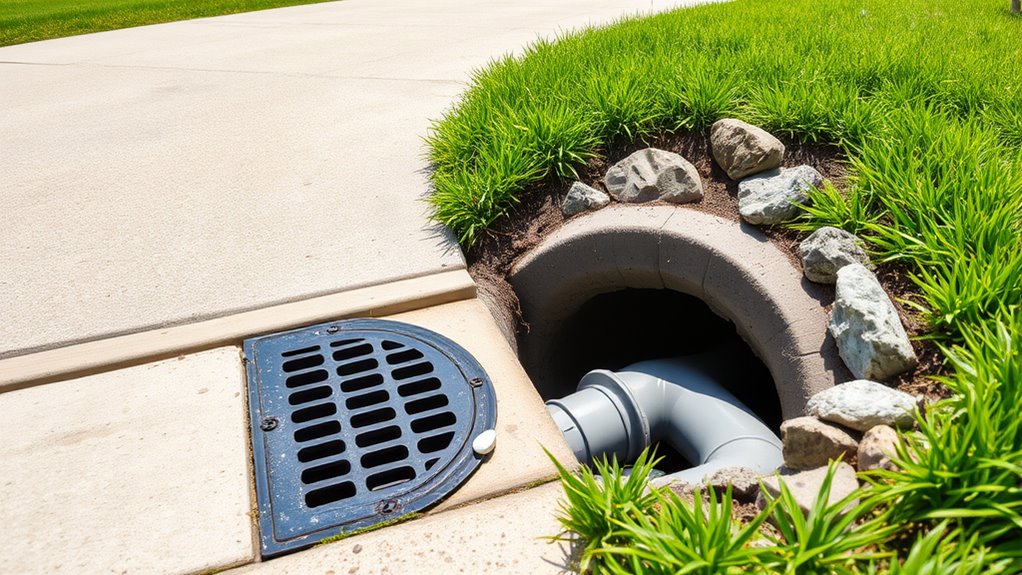
Managing stormwater effectively is essential for property owners to prevent flooding, erosion, and water damage. One popular solution is installing a rain garden, which captures runoff and allows it to soak into the ground naturally. This not only reduces water flow but also filters pollutants. Another effective option is a soakaway system, where you create a designated underground chamber that allows water to drain away safely. These systems help manage excess rainwater, especially during heavy storms, without overwhelming your property’s drainage. Both rain gardens and soakaway systems are environmentally friendly and cost-effective, making them excellent choices for property owners looking to control stormwater on their land. Proper implementation guarantees your property stays dry and protected during heavy rains.
Permits and Regulations You Need to Know
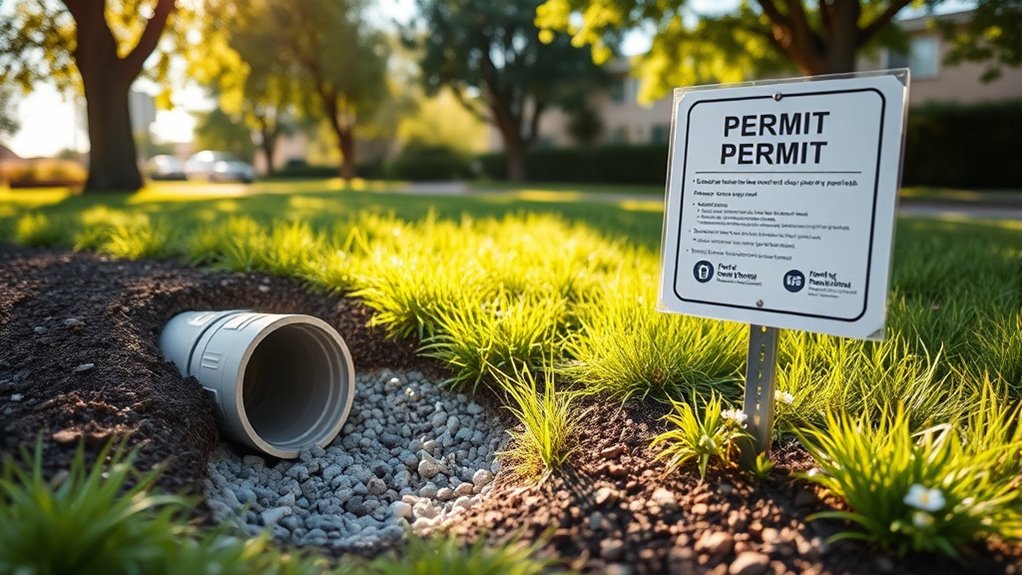
Before installing drain and discharge systems, you need to understand the permits and regulations that apply to your property. Managing permitting processes can feel overwhelming, but it’s essential to stay compliant and avoid costly fines. Local regulations vary widely, so you must research what rules apply in your area. Ignoring these requirements can lead to delays, legal issues, or environmental harm. Be aware that obtaining permits often involves inspections and documentation, making sure your system meets safety standards. Additionally, understanding Real Couples dynamics can help you navigate community expectations and maintain positive relationships with neighbors. Don’t underestimate the importance of following the rules—protect your property and community by staying informed.
- Avoid costly fines and legal trouble
- Guarantee your system is environmentally safe
- Speed up the installation process
- Protect your property’s value and reputation
Choosing the Right Discharge Method for Your Property
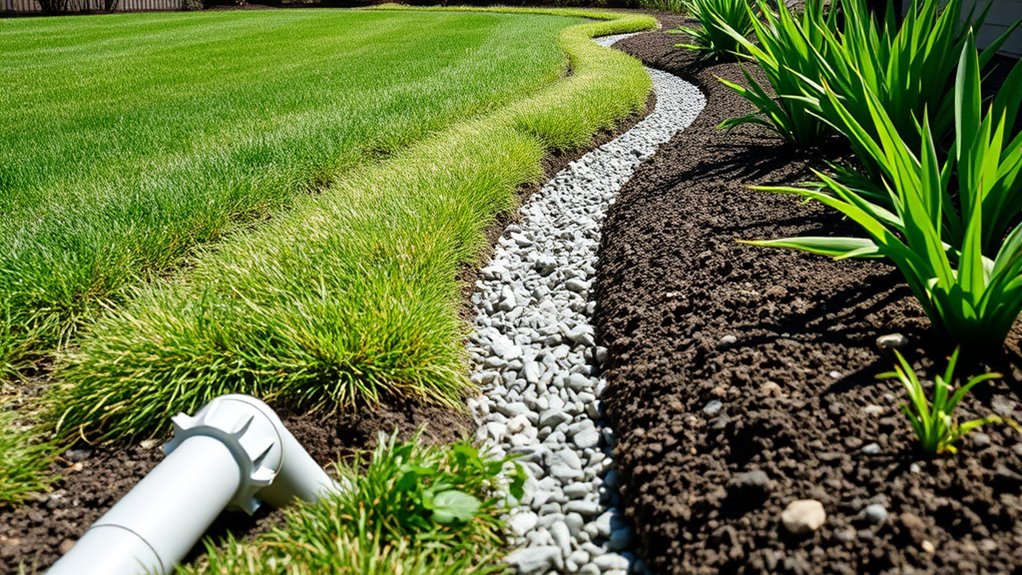
Choosing the right discharge method for your property guarantees your drainage system works efficiently and complies with local regulations. If you’re considering rainwater harvesting, ensure your system safely directs excess water away from foundations, reducing erosion and flooding risks. For properties with septic tanks, proper design is vital; choose a method that safely discharges effluent without harming the environment or violating regulations. Drainage options like soakaways or dispersal fields can work well if your soil absorbs water effectively. Evaluate your property’s slope, soil type, and water volume to select the most suitable method. Proper planning ensures your drainage system handles rainwater and septic discharge efficiently, preventing issues like backups or water damage while remaining compliant with local rules. Additionally, understanding wastewater flow rates can help you determine the capacity needed for your chosen drainage solution.
Common Problems and Maintenance Tips for Drainage Systems
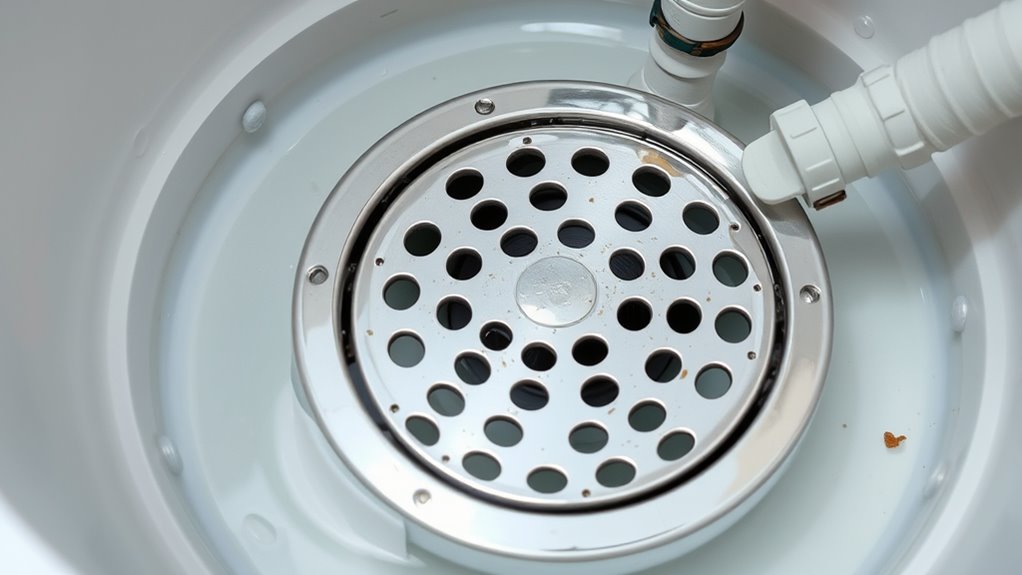
Drainage systems can face a variety of common problems over time, especially if they aren’t properly maintained. One major issue is drain clogging, which causes slow drainage or backups, leading to frustration and property damage. Pipe corrosion is another concern, weakening pipes and risking leaks or bursts. To prevent these problems, regularly clean your drains and avoid pouring grease or debris down the drain. Use enzyme-based cleaners to clear minor clogs safely. Inspect pipes for signs of corrosion, such as discoloration or rust, and replace damaged sections promptly. Proper maintenance can extend the lifespan of your drainage system and prevent costly repairs.
- Persistent clogs that resist removal
- Unpleasant odors emanating from drains
- Slow drainage during heavy use
- Visible rust or corrosion on pipes
Frequently Asked Questions
How Long Do Drainage Systems Typically Last Before Needing Replacement?
Drainage systems usually last between 20 to 30 years before needing replacement. To extend their lifespan, you should follow regular maintenance tips like cleaning drains and avoiding chemical overloads. Keep an eye out for signs of wear or blockage. Remember, delaying replacement can lead to costly repairs, so understanding replacement costs early helps you plan better. Proper upkeep guarantees your drainage system stays functional longer, saving you money in the long run.
Are There Eco-Friendly Discharge Options Available for Residential Properties?
You can definitely choose eco-friendly discharge options for your home. Think of rainwater harvesting like collecting a treasure chest of natural resources, reducing reliance on traditional systems. Green infrastructure, such as permeable pavements and vegetated swales, helps manage stormwater sustainably. These options lower your environmental impact, conserve water, and support local ecosystems. Embracing these methods makes your property more eco-conscious and resilient, turning your drainage system into a positive force for the environment.
What Are Signs of a Failing Drainage or Discharge System?
You’ll notice signs of a failing drainage system when you see clogged pipes or foul odors lingering around your home. Clogged pipes cause slow drainage or backups, while foul odors indicate waste isn’t flowing properly and may be leaking. If these issues persist despite cleaning, it’s a clear sign your drainage or discharge system needs inspection or repair to prevent further damage and maintain a healthy, odor-free environment.
Can I Upgrade My Existing Drainage System Without Professional Help?
Think of upgrading your drainage system as tuning a delicate instrument; it’s tempting but tricky. While DIY drainage upgrades are possible, they require careful planning, basic plumbing skills, and an understanding of local regulations. You can attempt simple fixes like clearing clogs or installing basic components, but for more complex upgrades, it’s best to call in a professional. Trust your skills and don’t risk causing costly damage.
How Do Climate Changes Affect Drainage and Discharge Planning?
Climate changes impact your drainage and discharge planning by increasing the frequency and intensity of storms, making effective stormwater management essential. You need to focus on climate adaptation strategies, like installing larger or more flexible drainage systems that can handle heavy rainfall. Planning ahead guarantees your property can manage these changes, reducing flooding risks and protecting your home. Staying updated on climate trends helps you make smarter choices for long-term drainage solutions.
Conclusion
Understanding your drainage and discharge options helps you stay ahead of trouble. By choosing the right system and keeping it well-maintained, you can avoid costly repairs and headaches down the road. Remember, a stitch in time saves nine—address issues early before they grow into bigger problems. Stay informed about regulations, and don’t be afraid to seek professional advice when needed. With proper care, your drainage system will serve you well for years to come.

